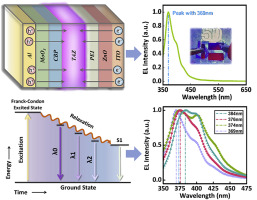Organic Electronics ( IF 3.2 ) Pub Date : 2020-03-19 , DOI: 10.1016/j.orgel.2020.105718 Jin Na , Sheng Bi , Chengming Jiang , Jinhui Song

|
Organic light emitting diode (OLED) has huge impact on display-related fields. Due to potential applications in information storage and backlight sources for full color display, ultraviolet OLED has attracted widespread attention. In this paper, we present an inverted UV OLED device with electroluminescence (EL) peak of 369 nm. The device employs zinc oxide (ZnO) as electron injection layer (EIL), revealing a relationship between the exciton diffusion and emitting peaks. The organic-inorganic interface in the device reduces the diffusion length of excitons and that can lead to a hampered relaxation of higher energy states, resulting in a hypsochromic shift of the EL spectrum. The existence of buffer layer will affect the relaxation process. Additionally, the emission peak of the UV-OLED can be adjusted from 369 nm to 384 nm by varying kinds and thickness of the organic functional layers.
中文翻译:

通过调整激子弛豫来实现紫外OLED的七色电致发光
有机发光二极管(OLED)对与显示相关的领域具有巨大影响。由于在全彩色显示的信息存储和背光源中的潜在应用,紫外线OLED引起了广泛的关注。在本文中,我们介绍了具有369 nm电致发光(EL)峰的反向UV OLED器件。该器件采用氧化锌(ZnO)作为电子注入层(EIL),显示出激子扩散和发射峰之间的关系。器件中的有机-无机界面减少了激子的扩散长度,并可能导致较高能态的弛豫受到阻碍,从而导致EL光谱的变色移动。缓冲层的存在会影响松弛过程。另外,


























 京公网安备 11010802027423号
京公网安备 11010802027423号